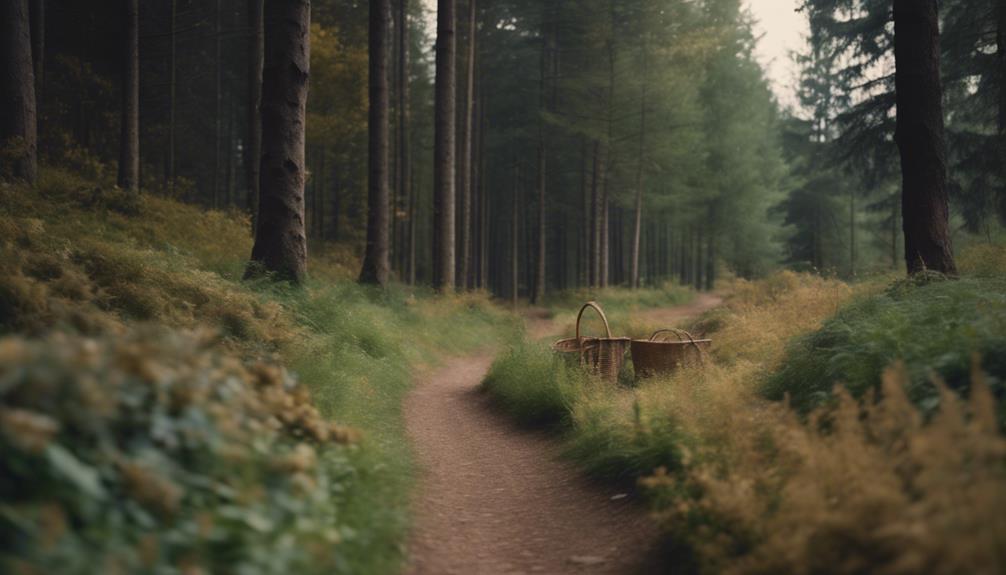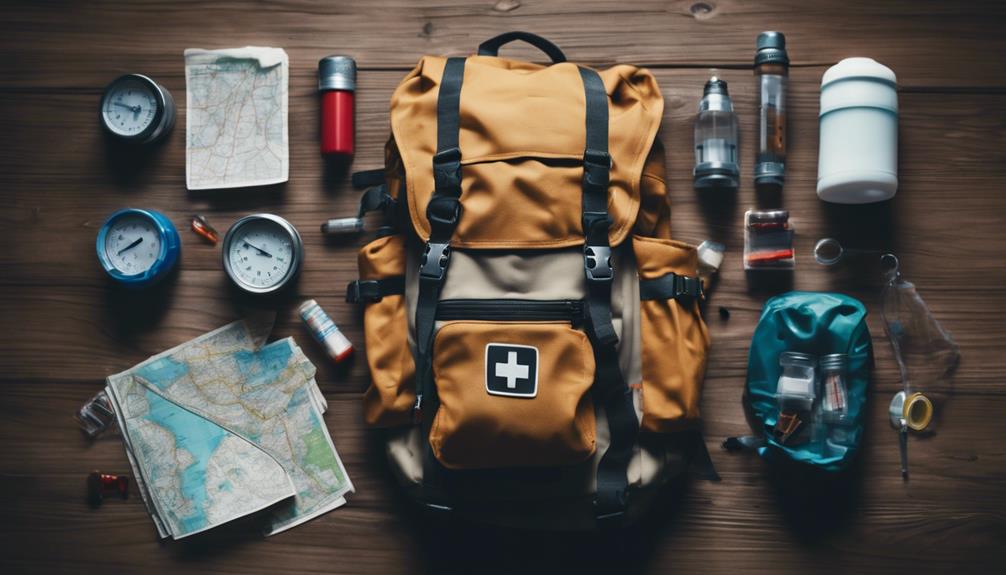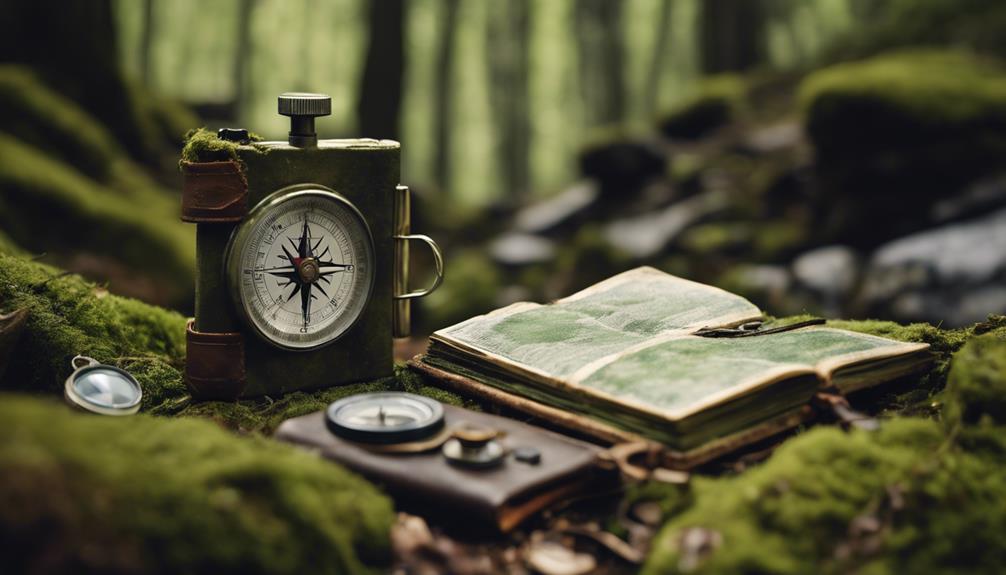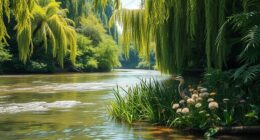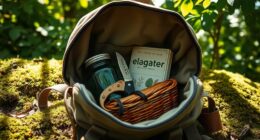Begin a foraging journey in New England with top picks like 'Foraging New England: Edible Wild Food and Medicinal Plants' for detailed layouts and photos. Discover 'Northeast Foraging' for useful plant tips during hikes. Explore 'Edible Wild Plants' for info on 200 foods, but get another guide for toxic plants. Check out 'Northeast Medicinal Plants' for detailed herb info. Identify mushrooms with 'National Audubon Society Field Guide.' 'Edible and Medicinal Mushrooms of New England and Eastern Canada' offers great mushroom insights. Boost confidence with 'Mushrooming Without Fear.' Find more tree tips in 'Tree Identification Book' for Eastern trees. Explore these gems for a wild bounty of knowledge.
Key Takeaways
- Detailed descriptions and photographs for accurate plant identification in New England.
- Practical guidance on finding, harvesting, and consuming wild edibles.
- Emphasis on sustainable harvesting practices and ecological responsibility.
- Regional coverage specific to states like Massachusetts, Vermont, Maine.
- Enriching foraging experience with popular plants like beach plums and wineberries.
Foraging New England: Edible Wild Food and Medicinal Plants (Foraging Series)

For New England explorers interested in discovering edible wild food and medicinal plants, 'Foraging New England: Edible Wild Food and Medicinal Plants' offers an extensive guide with informative content and helpful photographs.
The book presents a range of information and images showcasing the flora of the New England region. Some readers found the layout easy to navigate, particularly beneficial for beginners venturing into foraging. However, a few individuals expressed concerns about the level of detail and clarity in the photographs, suggesting improvements for easier plant identification.
Despite some shortcomings, the pictures taken in a pre-harvest setting were appreciated for aiding in plant recognition. Overall, the book seems to have sparked interest in foraging among readers, even if not all plants featured were deemed consumable.
Best For: Those new to foraging in the New England region looking for an introductory guide on edible wild food and medicinal plants.
Pros:
- Informative content and photographs beneficial for beginners.
- Layout easy to navigate.
- Sparks interest in foraging.
Cons:
- Lack of detail and clear photographs for plant identification.
- Some pictures not of sufficient quality for safe plant recognition.
- Absence of photographs of poisonous plant versions mentioned by a reader.
Northeast Foraging: 120 Wild and Flavorful Edibles from Beach Plums to Wineberries

Ideal for both seasoned foragers and novices, 'Northeast Foraging: 120 Wild and Flavorful Edibles from Beach Plums to Wineberries' serves as a thorough guide for exploring the bountiful wild edibles of the Northeast region. This well-written book features over 120 wild edible plant species, each chapter providing detailed information on identification, gathering, eating, preserving, future harvests, and any necessary warnings.
With chapters organized alphabetically by common plant names, readers can easily navigate through the book. The inclusion of photos enhances the identification process, making it easier to recognize edible plants while foraging. Additionally, the book offers valuable foraging tips on sustainable harvesting practices, emphasizing the importance of responsible foraging to maintain ecological balance in the region.
Whether you're a beginner or an experienced forager, 'Northeast Foraging' is a valuable resource for discovering the diverse edible treasures of the Northeast.
Best For: Nature enthusiasts and foragers in the Northeast looking to explore and identify a wide variety of wild edibles in the region.
Pros:
- Detailed plant descriptions and informative foraging tips.
- Practical guide for identifying edible plants while hiking or foraging.
- Emphasis on sustainable harvesting practices and ecological responsibility.
Cons:
- May require supplementary resources for more in-depth knowledge on specific plants.
- Limited geographic focus on the Northeast region.
- Potential need for additional caution due to warnings on toxic plants or look-alikes.
Edible Wild Plants: A North American Field Guide to Over 200 Natural Foods

A must-have resource for any outdoor enthusiast exploring the wilderness of New England is the detailed guidebook, 'Edible Wild Plants: A North American Field Guide to Over 200 Natural Foods.'
This all-inclusive guide features color pictures of various herbs, aiding in easy plant identification. It's organized into chapters that allow for quick reference based on seasons, locations, and plant uses, with a helpful cross-referencing index system. The heavy-duty glossy cover and durable paper stock make it suitable for expeditions.
While some pictures are in black and white, requiring a bit more effort for identification, the book provides extensive information on safe edible plants. Reader reviews highly recommend this guide for its detailed descriptions, recognizable plant images, and valuable content for those interested in outdoor adventures or survival situations.
Best For: Outdoor enthusiasts, survivalists, and herbalism enthusiasts seeking a comprehensive guide to identifying and utilizing edible wild plants in North America.
Pros:
- Detailed descriptions and recognizable plant pictures aid in easy identification.
- Organized chapters and cross-referencing index system for quick reference.
- Valuable information on over 200 natural foods, focusing on safe plants for consumption.
Cons:
- Some pictures are in black and white, slightly hindering plant identification.
- Advises getting a companion book on toxic plants, which may require additional purchase.
- The heavy-duty glossy cover may add weight for those looking for ultra-light expedition gear.
Northeast Medicinal Plants: Identify, Harvest, and Use 111 Wild Herbs for Health and Wellness

The book 'Northeast Medicinal Plants: Identify, Harvest, and Use 111 Wild Herbs for Health and Wellness' stands out as the go-to resource for individuals seeking extensive information on identifying and utilizing wild herbs in the New England region.
With rich, detailed color pictures aiding in plant identification, this book provides convenient regional information essential for on-the-go use. Detailed descriptions not only reveal where to find plants and how they grow but also guide on which parts to harvest.
From directions on using plants as medicine to precautionary warnings, this book equips readers with practical knowledge, including the correlation between plant characteristics and their medicinal uses. Compared to other books, its wealth of information, easy plant identification through color photographs, and organization make it a top choice in the field of foraging.
Best For: Those interested in exploring and utilizing wild herbs in the Northeast region for health and wellness.
Pros:
- Rich, detailed color pictures aiding in plant identification.
- Convenient regional information for on-the-go use.
- Detailed descriptions on plant locations, growth, and harvesting guidelines.
Cons:
- Lack of identification for toxic plants in the Northeast.
- Limited information on the ecological impact of harvesting wild herbs.
- May not cover all potential medicinal uses of the plants mentioned.
National Audubon Society Field Guide to North American Mushrooms

Ideal for mushroom enthusiasts exploring New England, the National Audubon Society Field Guide to North American Mushrooms provides extensive information and detailed illustrations for identifying a variety of fungi species. This guide has received rave reviews for being a great tool for mushroom foraging, with users praising its easy readability and thorough content.
Its well-organized layout, along with beautiful diagrams and photos, makes it a must-have for anyone interested in mycology. Users have found the book to be a valuable reference, with positive experiences shared in different languages.
Despite being out of print at times, the guide is now back in stock at a reasonable price, offering a compact size and high-quality stock that make it a convenient and informative companion for mushroom hunting adventures.
Best For: Outdoor enthusiasts and nature lovers interested in identifying and exploring a variety of mushroom species.
Pros:
- Comprehensive content with detailed information for identifying mushrooms
- Beautiful photos and illustrations for easy reference
- Compact size and flexible cover for portability on outdoor adventures
Cons:
- Some users find it challenging to quickly look up specific mushrooms
- May not cover every single mushroom species in North America
- Availability may vary, leading to potential out-of-stock situations
Edible and Medicinal Mushrooms of New England and Eastern Canada

Best choice for New England explorers seeking to explore the world of edible and medicinal mushrooms in the region. 'Edible and Medicinal Mushrooms of New England and Eastern Canada' is a thorough guide that explores the fascinating world of mycology.
This book not only aids in identifying various mushrooms but also sheds light on their ecological significance and offers practical advice for successful foraging trips. With detailed information and engaging narratives, readers can enhance their understanding of mushrooms and their role in the environment.
From learning about different species to discovering recipes and preparation methods, this book equips enthusiasts with the knowledge needed to explore and appreciate the diverse array of edible and medicinal mushrooms found in New England and Eastern Canada.
Best For: Nature enthusiasts and mushroom foraging beginners in New England and Eastern Canada.
Pros:
- Comprehensive guide to identifying edible and medicinal mushrooms.
- Engaging narratives and high-quality photographs enhance learning.
- Practical tips and recipes provided for successful foraging experiences.
Cons:
- Limited focus on mushrooms outside of New England and Eastern Canada.
- Some readers may find the content overwhelming if new to mycology.
- Lack of in-depth scientific explanations for advanced enthusiasts.
Mushrooming Without Fear: Beginners Guide to Collecting Safe and Delicious Mushrooms

A must-have guide for aspiring foragers in New England, 'Mushrooming Without Fear' offers beginners a thorough introduction to collecting safe and delectable mushrooms. The book has received positive reviews for its helpful information presented in easy-to-understand language, complete with a color guide to aid identification.
It's particularly praised for building confidence in identifying safe mushrooms, helping readers overcome fears associated with harvesting and consuming wild fungi. While some critiques mention its focus on only two common mushroom types and the lack of information on gill-type mushrooms, overall, the book is appreciated for its value for beginners.
Readers have expressed gratitude for the book's content, size, and portability, making it a valuable resource for those venturing into the world of mushroom foraging.
Best For: Those new to mushroom foraging who are seeking a beginner-friendly guide with clear information and confidence-building tips.
Pros:
- Clear and easy-to-understand language with a color guide for identification.
- Builds confidence in identifying safe mushrooms.
- Helpful for beginners looking to overcome fears of harvesting wild fungi.
Cons:
- Limited coverage of mushroom varieties, focusing on only two common types.
- Lack of information on gill-type mushrooms.
- Some readers may prefer a more comprehensive guide with a wider range of mushrooms covered.
The Complete Guide to Edible Wild Plants

One essential resource that stands out for those keen on exploring edible wild plants in New England is 'The Complete Guide to Edible Wild Plants'. This guide has received positive feedback for being easy to understand, featuring good graphics, and being portable and lightweight. It's recommended for beginners and covers a variety of ecosystems, making it a useful tool for researching edible plants.
The book provides clear warnings and precautions, making it helpful for survival situations. Additionally, it offers valuable information for those interested in eating local and includes lovely photos for identification. While some reviewers have criticized the picture quality and the limited coverage of plants, overall, 'The Complete Guide to Edible Wild Plants' is recommended for anyone looking to learn about edible wild plants in New England.
Best For: Beginners and outdoor enthusiasts looking to learn about edible wild plants in New England.
Pros:
- Easy to understand
- Good graphics
- Portable and lightweight
Cons:
- Issues with picture quality
- Limited coverage of plants
- Some images are drawings
The Lost Kitchen: Recipes and a Good Life Found in Freedom, Maine: A Cookbook

When exploring New England, any cooking enthusiast intrigued by creative recipes and seasonal ingredients might find 'The Lost Kitchen: Recipes and a Good Life Found in Freedom, Maine: A Cookbook' a delightful addition to their culinary adventures.
This cookbook offers a variety of well-written and creative recipes, beautifully presented with a heavy tweed cover and matte color photos. Organized by seasons, the book not only provides delicious dishes but also shares inspiring stories about chef Erin French's culinary journey.
Reviewers praise the gourmet recipes, such as the golden beet soup, for being both easy to follow and delectable. However, some users mention challenges in sourcing ingredients like edible flowers and razor clams, which could be a drawback for those outside Maine.
While opinions on practicality vary, 'The Lost Kitchen' is recommended for its quality, recipes, and overall content.
Best For: Individuals residing in Maine or with easy access to local, fresh ingredients seeking creative and gourmet recipes inspired by seasonal cooking.
Pros:
- Well-written and creative recipes organized by seasons.
- Beautifully presented with a heavy tweed cover and matte color photos.
- Inspiring stories about chef Erin French's culinary journey.
Cons:
- Challenges in sourcing ingredients like edible flowers and razor clams.
- Practicality may vary for users outside of Maine.
- Potential for the book to collect dust if not used regularly.
Southeast Foraging: 120 Wild and Flavorful Edibles

The book 'Southeast Foraging: 120 Wild and Flavorful Edibles' is an excellent resource for those looking to explore and forage wild edibles in the New England region. With high-quality pictures and detailed information, this guide is super informative and serves as an excellent reference for foraging enthusiasts.
The beautiful full-color photos make plant identification easy, while the instructions provided for sustainable harvest and plant uses enhance the foraging experience. User reviews praise the book's clear colored pictures and its value as a learning tool for edible plants specific to the region.
Although some users suggested wanting more plants and pictures, overall, 'Southeast Foraging' has proven to be a valuable asset for individuals interested in foraging in the Southeastern United States.
Best For: Individuals living in rural areas of the Southeastern United States who are interested in learning about and foraging wild edibles.
Pros:
- High-quality pictures and information.
- Excellent reference guide for foraging in the region.
- Provides instructions for sustainable harvest and plant uses.
Cons:
- Some users wished for more plants and pictures.
- Potential issue with wet packaging.
- E-book may have visibility limitations for practical foraging use.
How to Forage for Mushrooms without Dying: An Absolute Beginners Guide

Discover essential tips for safe and successful mushroom foraging in the beginner-friendly guide 'How to Forage for Mushrooms Without Dying: An Absolute Beginner's Guide' by Frank Hyman. This book offers a practical approach to mushroom foraging, focusing on basic mushroom knowledge, safety precautions, and identifying edible species.
It covers the process of foraging, from what to look for and where to find mushrooms to how to cut, cook, and store them properly. Emphasizing caution, the book helps beginners differentiate between edible and toxic mushrooms, featuring descriptions and images of 29 edible species and 5 poisonous ones.
User reviews praise its usefulness, clear explanations, and helpful guidance. With this book as a companion, beginners can gain confidence in their mushroom foraging skills and enjoy the wild bounty safely.
Best For: Beginners interested in safely exploring the world of mushroom foraging with a practical and informative guide.
Pros:
- Comprehensive coverage of foraging process and mushroom identification
- Emphasis on safety and caution when foraging for mushrooms
- Clear descriptions and photographs of edible and toxic mushroom species
Cons:
- Limited focus on advanced mushroom foraging techniques
- Lack of in-depth information on rare or less common mushroom species
- Some readers may prefer more detailed cooking and recipe suggestions
Tree Identification Book: Practical Tree Identification & Recognition

Ideal for any New England explorer seeking to quickly and accurately identify local tree species, the 'Tree Identification Book: Practical Tree Identification & Recognition' offers a user-friendly approach with clear photos and practical methodology.
This book presents a handy method for tree identification through visual keys and detailed images of tree characteristics like twigs, leaves, and bark. Users have praised its accessibility and effectiveness in pinpointing different tree species. While some reviewers appreciate the explanations and methodology provided, there are mixed opinions on the lack of color photos, with some readers preferring more vibrant illustrations.
Geared towards Eastern U.S. tree species, this book may not be as suitable for those on the West Coast. Despite covering around one hundred tree species, it may have limitations for in-depth biological studies. Users recommend this book for personal identification, educational use, or as a helpful reference tool.
Best For: Outdoor enthusiasts and amateur naturalists in the Eastern United States seeking a practical tool for identifying local tree species.
Pros:
- Clear and useful photos of tree features aid in easy identification.
- Practical methodology and explanations make tree identification accessible.
- Valuable reference tool for personal or educational use.
Cons:
- Limited geographical coverage focusing mainly on Eastern U.S. tree species.
- Lack of color photos may be a drawback for some users.
- Coverage of around one hundred tree species may not be comprehensive for advanced biological studies.
Peterson Field Guide To Mushrooms Of North America, Second Edition

A go-to resource for identifying mushrooms in New England, the Peterson Field Guide To Mushrooms Of North America, Second Edition offers detailed illustrations and informative content suitable for both beginners and enthusiasts.
This all-encompassing guide features colorful illustrations that assist in accurately identifying various mushroom species found in the US and Canada. It provides valuable insights into mushroom identification techniques and essential mushroom information in a compact and easy-to-understand format.
Users have praised the book for its user-friendly layout and the quality of its illustrations, making it a popular choice for mushroom hunting expeditions. With updated artwork and scientific information in the second edition, this guide is recommended for anyone interested in exploring the fascinating world of mushrooms.
Best For: Mushroom enthusiasts and beginners looking for a comprehensive guide to identifying mushrooms in North America.
Pros:
- Detailed and colorful illustrations aid in accurate mushroom identification.
- Compact and easy-to-use layout makes it convenient for field use.
- Updated artwork and scientific information in the second edition enhance the overall quality of the guide.
Cons:
- Some users may find the level of detail overwhelming if they are just starting out in mushroom identification.
- Limited coverage of certain regional variations or lesser-known species.
- May not delve deeply into advanced mushroom identification techniques for experienced mycologists.
Forget The Pharmacy – Grow Your Own Medicine: The Homesteaders Ultimate Self-Sufficient Guide to Grow Herbs

When exploring herbalism and natural remedies tailored to the New England region, this book is the perfect resource for those seeking to cultivate their own medicine. 'Forget The Pharmacy – Grow Your Own Medicine: The Homesteaders Ultimate Self-Sufficient Guide to Grow Herbs' offers an in-depth look into herbalism basics, emphasizing the benefits of cultivating medicinal plants at home.
From first aid to maintaining overall well-being, the book covers various aspects of herbal medicine tailored to everyday ailments. With detailed insights on growing, caring for, and harvesting herbs like Aloe Vera and rosemary, readers can journey towards self-sufficiency in health management.
By encouraging a shift towards natural remedies, this guide equips beginners and enthusiasts alike with valuable information to craft their own herbal solutions.
Best For: Those interested in cultivating their own herbal remedies and exploring natural health solutions tailored to the New England region.
Pros:
- Detailed insights on growing and caring for medicinal herbs like Aloe Vera and rosemary.
- Emphasis on self-sufficiency in health management through herbalism basics.
- Encourages a shift towards natural remedies for everyday ailments.
Cons:
- May require significant time and effort to establish and maintain a herbal garden.
- Some readers may prefer more scientific evidence supporting the effectiveness of herbal remedies.
- Limited focus on specific health conditions and corresponding herbal treatments.
Factors to Consider When Choosing Foraging Books for New England

When selecting foraging books for New England, it's essential to take into account key book features, regional coverage details, reader experience insights, visual content quality, and practical application tips.
These factors play a significant role in ensuring the book aligns with your foraging goals and provides valuable information for your explorations in the region.
Essential Book Features
Considering the vast array of plant species found in New England, selecting foraging books with key features can greatly enhance your foraging experience and success. Look for books that provide clear and detailed photographs of plants, aiding in easy identification while out in the wild.
Organized by region or season, these books can help match your foraging location and timing, maximizing your chances of finding the right plants at the right time. Practical foraging tips on gathering, eating, and preserving edible plants are essential features to seek in a foraging book.
Additionally, emphasize sustainability and responsible foraging practices by choosing books that promote these values. To ensure a thorough guide, opt for books that include information on plant warnings, toxic look-alikes, and even medicinal uses.
Regional Coverage Details
To make informed choices when selecting foraging books for New England exploration, it's important to focus on the regional coverage details offered in the guides.
Look for books that explore the wild edibles and medicinal plants specific to states like Massachusetts, Vermont, Maine, and others in the region. Guides that encompass a wide range of plant species found in New England, such as beach plums and wineberries, can enrich your foraging experience.
Consider resources that not only cover plants from popular foraging states like Connecticut, New Hampshire, and Rhode Island but also provide detailed descriptions and photographs for accurate plant identification in the New England area.
Emphasizing sustainability and responsible foraging practices, the best books will guide you on how to harvest ethically in this rich region. By prioritizing regional specificity and thorough coverage, you can make sure that your foraging adventures in New England are both fruitful and environmentally conscious.
Reader Experience Insights
Reader feedback on foraging books in New England reveals varying levels of satisfaction, highlighting key factors to take into account when selecting a guide. Positive experiences often revolve around books sparking an interest in foraging and offering valuable knowledge, particularly for beginners. Many readers appreciate these guides as gifts that open up opportunities to explore the abundance of edible plants in the region. However, some readers express frustration with certain books due to limited regional specificity or unclear identification methods. For those looking to expand their skills beyond New England, recommendations for the best Midwest foraging books often surface in discussions, offering more tailored guidance for exploring different ecosystems. These comparisons highlight the importance of selecting a guide that suits both the reader’s location and experience level.
However, critiques commonly mention shortcomings such as a lack of detailed information, unclear photographs, or insufficient coverage of toxic plants for safety. Suggestions for improvement include incorporating a broader variety of plants, clearer images for easier identification, and a more thorough overview of poisonous species in the area.
When choosing a foraging book, one should bear in mind these factors to ensure that the guide meets your needs and expectations, whether you're a novice or a seasoned forager looking to expand your knowledge.
Visual Content Quality
When selecting foraging books for New England, prioritizing clear, high-quality photographs is essential for safe plant identification and learning about plant features effectively.
Detailed and colorful illustrations play an important role in aiding the easy recognition of edible plants and mushrooms. The visual content quality greatly impacts the effectiveness of comprehending plant characteristics.
Crisp, close-up images are particularly helpful in distinguishing between different plant species accurately, ensuring a successful foraging experience.
Additionally, bright, colored photographs not only enhance the overall visual appeal but also increase the usefulness of foraging guides by making the identification process more accessible and enjoyable.
Hence, when browsing for foraging books, pay close attention to the quality of the visual content, as it can make a substantial difference in your ability to identify and interact with the diverse plant life found in the New England region.
Practical Application Tips
Considering the importance of practical application when choosing foraging books for New England, it's essential to focus on factors that enhance the overall foraging experience and safety. Look for books that not only list edible plants but also provide specific tips on where and when to find them in the diverse New England landscape. Practical guidance on identifying, harvesting, and safely consuming wild edibles is vital for a successful foraging outing. Additionally, selecting books that emphasize sustainable harvesting practices ensures that we gather responsibly, preserving the natural ecosystem for future generations.
When exploring foraging books, prioritize those that detail different uses of edible plants, whether for raw consumption, cooking, or preservation methods. Understanding how to prepare and store wild edibles can greatly enhance the foraging experience.
Furthermore, books that include warnings about toxic plants or look-alikes to avoid are invaluable for ensuring a safe and enjoyable foraging adventure in New England. By considering these practical application tips, foragers can make informed choices and fully appreciate the diverse bounty of the region.
Frequently Asked Questions
Can Foraging Be Done in Urban Areas of New England?
Foraging can definitely be done in urban areas of New England. I've found wild edibles like dandelions and purslane in city parks. Just make sure to research plants and avoid polluted areas. Happy hunting!
Are There Any Safety Precautions for Foraging in New England?
When foraging in New England, I always prioritize safety. It's essential to properly identify plants, avoid toxic look-alikes, and steer clear of polluted areas. Wearing gloves, using a guidebook, and consulting local experts are wise precautions.
How Do I Properly Store Foraged Wild Edibles?
To properly store foraged wild edibles, I recommend refrigerating perishable items promptly. Use airtight containers for longer shelf life. Label and date everything. Guarantee proper ventilation for items like mushrooms. Remember safety and cleanliness are key.
Are There Any Legal Restrictions on Foraging in New England?
Oh, the joy of foraging in New England! As much as I love gathering wild goodies, it's important to respect local laws. Remember, it's not a free-for-all – always check regulations beforehand.
Can Foraging Have a Negative Impact on Local Ecosystems?
Foraging can have a negative impact on local ecosystems if done unsustainably. Over-harvesting can disrupt plant populations, disturb wildlife habitats, and alter delicate ecological balances. Responsible foraging practices are essential to preserve biodiversity.
Conclusion
To sum up, exploring the wild bounty of New England through foraging can be a rewarding and enriching experience. With the right foraging books as your guide, you can discover a whole new world of edible wild food and medicinal plants right in your own backyard.
So why not grab a book, head out into nature, and see what treasures await you? Happy foraging!


